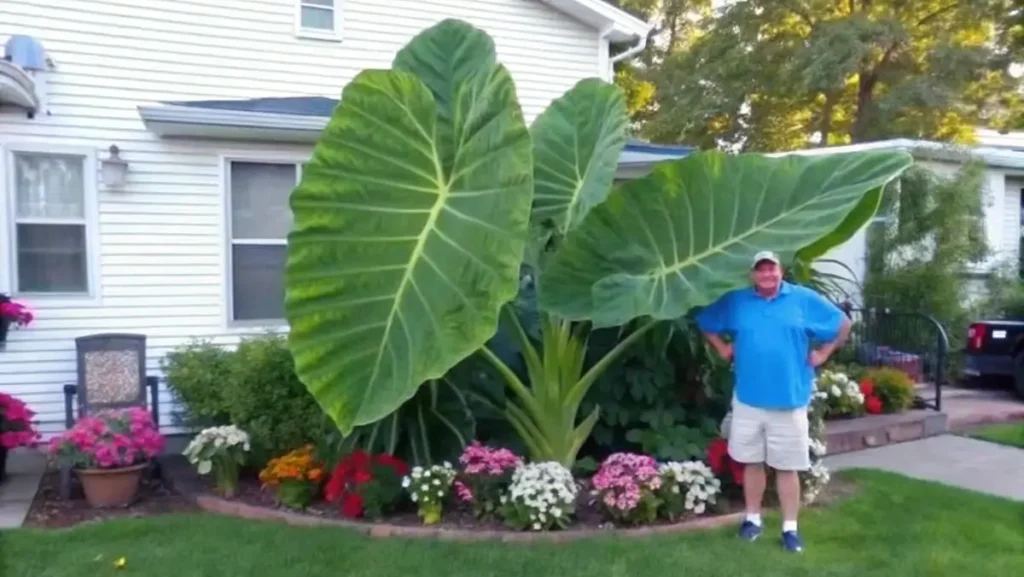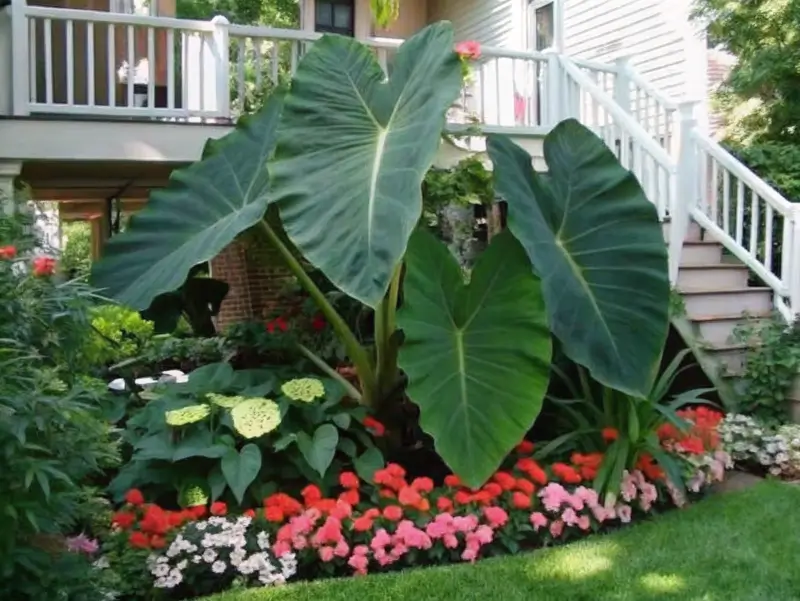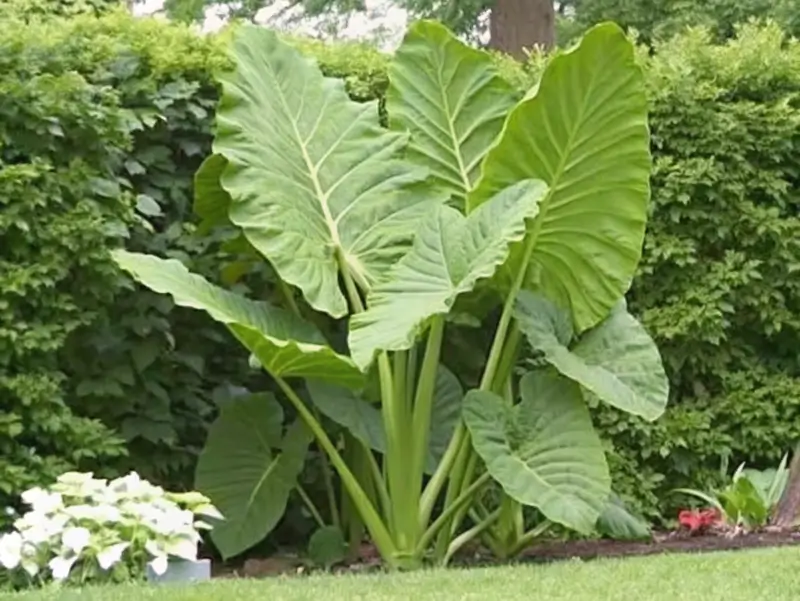
Prepare to explore one of the most striking greens in the plant universe—elephant ears plant. Expect insights into different leaf shapes and elephant ear plant types, plus tips on planting bulbs for healthy growth. Learn how to care for elephant ear plant indoors and outdoors, and get solutions for pests. Afterward, you’ll have a clear guide to elephant ear plants. Honestly, these broad leaves never fail to truly impress onlookers!
Table of Contents
Introduction to Elephant Ears Plant
What Makes the Elephant Ears Plant So Unique
Let me start by saying that elephant ears plant gets its name from those huge leaves that resemble, well, elephant ears. These leafy wonders usually come from tropical regions, so they thrive under warm and humid conditions.Folks who love big, dramatic leaves are instantly hooked:
- The leaves can measure a few feet across.
- The plant brings a tropical vibe to your home or garden.
- It’s a centerpiece that steals the spotlight.
Meanwhile, if you provide the correct light, moisture, and moderate temperatures, you’ll be amazed at how tall elephant ears plant can grow. I once had a pot that reached up to my hips in just one season. Now that’s what I call a wow factor!
Why Gardeners Love These Statement Leaves
On the one hand, elephant ears plant stands out because:
- It offers a dramatic focal point in both indoor and outdoor spaces.
- Its large ornamental leaves blend well with many other flowers or foliage plants.
- It’s relatively easy to maintain, even for beginners.
On the other hand, some folks get nervous about the watering needs or the leaf size. However, once you master a few basics, you’ll be unstoppable. Personally, I adore pairing them with exotics like the Alocasia Frydek to craft that bold, jungle-like effect. So, fear not—these plants are friendlier than they might appear!
Understanding Elephant Ear Plant Types
Colocasia vs. Alocasia: Key Differences
When diving into elephant ear plant types, you’ll quickly discover that Colocasia and Alocasia are two primary groups. Although both boast those impressive leaves, there are notable differences:
- Colocasia (Taro): Leaves typically hang downward. They require slightly more water.
- Alocasia: Leaves usually point upward, and they often display unique vein patterns.
I recall that I once confused Alocasia for Colocasia—it took me weeks to realize why my plant’s leaves were “standing” while my friend’s were flopping downward. But it’s all part of the learning process. Both are brilliant in the right conditions.
Top Cultivars and Their Distinct Features
If we talk about popular picks, one superstar is the black elephant ear plant. It dazzles with its deep, dark leaves that add a mysterious touch. Also, some purple elephant ears or “Blue Hawaii” variants can bring subtle tints that pop under bright light.Here are some highlights to check out:
- Colocasia esculenta “Black Beauty”: Incredible dark foliage.
- Alocasia macrorrhizos: Known for massive leaves that stand upright.
- Other elephant ear plant types featuring variegation or unusual coloration.
For those hoping to create a statement indoors, choosing an elephant ear houseplant version is also possible, but it requires consistent humidity and decent lighting. I’ll get into that later.
Ideal Growing Conditions for Elephant Ears Plant

Temperature, Light, and Humidity Requirements
Most elephant ear plants hail from warm, tropical areas, so they don’t appreciate cold zones. In general:
- They do best between 65°F and 85°F.
- They enjoy bright, filtered light or partial shade.
- They commonly prefer high humidity levels (think 60-80%).
In my experience, direct midday sun can scorch those massive leaves, especially if the air is dry. However, if you place them in partial shade with decent warmth, they’ll reward you with lush growth.
Best Soil Mix and pH Levels
Elephant ears plant loves soil that’s:
- Rich in organic matter.
- Slightly acidic to neutral (pH between 5.5 and 7.0).
- Well-draining but retains enough moisture.
I usually mix compost or aged manure into the planting hole to provide steady nutrients. If your soil feels too clay-like, add perlite or coarse sand to improve drainage. Because these leaves can get huge, it’s crucial to avoid waterlogged roots, or you’ll see yellowing or rot.
Planting and Propagation Techniques
Starting Planting Elephant Ear Bulbs: Step-by-Step Guide
If you’re planting elephant ear bulbs for the first time, check out these steps:
- Dig a hole 2–4 inches deep.
- Place the bulb with the pointed side facing up.
- Backfill with soil and pat lightly.
- Water thoroughly to settle the soil.
I remember my initial time planting elephant ear bulbs: I poked them in a pot, threw in some compost, and prayed. Within a few weeks, tiny shoots started appearing! That feeling was priceless.
Propagating via Division or Offshoots
If you already own mature elephant ear plants, you might notice baby offsets near the main corm. Carefully separate these when repotting:
- Gently dig around the base to locate the offshoot or baby corm.
- Detach it with clean pruning shears.
- Replant it in a new container or different spot in the garden.
Before you know it, you’ll have a whole family of elephant ear plants—just like I did last year when I ended up with five spares!
Watering and Fertilizing Elephant Ears Plant for Optimal Growth

Irrigation Tips to Avoid Overwatering
Elephant ear houseplant versions crave water but don’t want to drown. Thus:
- Keep the soil consistently moist, but not sopping wet.
- Let the top inch dry slightly before watering again.
- In containers, use pots with drainage holes.
Because elephant ears plant has big leaves, it transpires a lot, so you’ll likely water more often in warm seasons. However, always check mid-level moisture to prevent root rot.
Choosing the Right Fertilizer and Application Schedule
Giant leaves require ample nourishment. Typically, a balanced fertilizer applied every 2–4 weeks during the growing season works wonders. You can also try:
- Organic compost teas.
- Slow-release pellets.
- Fish emulsion for a nutrient boost.
Like me, if you prefer an organic route, compost is fantastic. Meanwhile, watch for leaf tip burn—too many salts from chemical fertilizers can damage your elephant ears plant. Remember to flush the pot occasionally with plain water.
Common Problems and Pests Affecting Elephant Ears Plant
Identifying Fungal Infections and Leaf Damage
Because of their broad surface area, elephant ear plants can be prone to fungal or bacterial issues. For instance:
- Leaf spot diseases may appear as black or brown patches.
- Overly damp, stuffy conditions can promote fungal attacks.
- Excess moisture plus low airflow becomes a recipe for trouble.
If you spot rotting or discolored leaves, prune them quickly and discard them in the trash. This helps prevent spread. I learned the hard way once by letting a couple of infected leaves linger on the plant—oops!
Natural and Chemical Pest Control Approaches
Spider mites, aphids, or mealybugs may target your prized elephant ear houseplant. To tackle these uninvited guests:
- Spray leaves with neem oil or insecticidal soap.
- Wipe the foliage gently to remove eggs or residue.
- Increase humidity levels to deter spider mites.
If the infestation is severe, a chemical insecticide might be your last resort. However, always test it on a small leaf patch before dousing the entire elephant ears plant.
Overwintering and Seasonal Care

Storing Elephant Ears Plant Bulbs During Colder Months
If you live somewhere that drops below freezing, you can store bulbs indoors:
- Gently dig up the corms after the foliage dies back.
- Brush off excess soil and let them dry for a few days.
- Pack them in peat moss or wood shavings, then keep them in a cool, dry spot.
Believe me, once spring arrives, you can replant them, and they’ll burst back with new leaves. If you’re lucky to live in mild climates, you might just leave them in the ground, maybe mulched for protection.
Ensuring Robust Regrowth in Warmer Seasons
When the weather warms, plant your stored bulbs back outside or move your potted elephant ear plants to the patio. Watch the forecast, though—sudden cold snaps can stunt new growth. If you’re not sure about your climate’s compatibility, check the USDA plant hardiness map to see if your region is plant-friendly. Then, once steady warmth hits, get them back into partial shade, water generously, and watch those giant leaves unfold again.
Landscaping Ideas with Elephant Ears Plant
Creating Dramatic Focal Points in the Garden
Plant lovers often group multiple elephant ears plant together for a powerful visual. Or they’ll place one as a standalone centerpiece. If you have a water feature, consider planting them near a pond’s edge for extra moisture and a stunning reflection. I’m obsessed with the effect of dark leaves shimmering around a small garden waterfall.
- Use them as background foliage behind shorter flowers.
- Mix them with vibrant annuals for color contrast.
- Place them along pathways to create a tropical corridor.
If you’re exploring statement plants for your home interior, let me throw in another suggestion: the White Wizard Philodendron is a gorgeous counterpart to your elephant ear houseplant.
Pairing Elephant Ears Plant with Other Ornamental Plants
To achieve that layered, decorative landscaping:
- Add taro plant variations for a twist on leaf shapes.
- Use ferns or hostas around the base to cover the bare stem.
- Select sumptuous foliage plants like caladiums for bursts of pink or red.
- Try ornamental grasses for fine-textured contrast.
This approach creates lush, moist soil requirement groupings that reflect a rainforest-inspired style. Watch for wind exposure, though—those large leaves can tear if caught in a gale.
FAQs About Elephant Ears Plant
Do Elephant Ears Like Sun or Shade?
Typically, elephant ears plant appreciates partial shade or bright, indirect light. Harsh midday sun can scorch the leaves, leading to yellowish edges or brown tips. Indoors, place your elephant ear houseplant near a window with filtered sunlight. Outdoors, morning sun followed by afternoon shade is a winning combo.
Do Elephant Ears Come Back Every Year?
They will, in warmer zones (USDA 8 and up). However, in colder climates, the bulbs might need winter storage, or they’ll freeze. If you mulch heavily and your ground doesn’t freeze too deeply, you could see fresh leaves pop up come spring. Usually, elephant ear plants bounce back when handled correctly.
What Is the Problem with Elephant Ears Plants?
Some folks worry about elephant ear toxicity, since the leaves have calcium oxalate crystals that can irritate skin or cause a burning sensation if ingested. Moreover, you need to manage:
- Consistent moisture.
- High humidity.
- Sufficient warmth.
If you’re comfortable providing those conditions, you’ll likely experience few issues. Wear gloves if you’re sensitive to plant sap.
What Do You Do If You Touch an Elephant Ear Plant?
If your skin reacts, rinse thoroughly with soap and water. Most individuals don’t have a serious reaction, but it’s similar to dealing with other mildly irritating plants. Whenever I prune my elephant ears plant, I slip on a pair of gloves, just to be safe. Better to avoid any annoying rash!
Conclusion and Additional Tips
Summarizing Key Takeaways for Elephant Ears Plant Success
These tropical stunners can transform your living environment if you treat them right. Here’s the quick rundown:
- Provide a warm environment (65–85°F).
- Offer partial shade or bright, filtered light.
- Keep soil moist but not waterlogged.
- Feed regularly with a balanced fertilizer.
- Take measures to overwinter bulbs if your region is cold.
From my perspective, mastering elephant ear plant care becomes almost second nature after a season or two. If you can meet the humidity and watering needs, you’ll see some amazing growth.
Resources and Future Considerations
If you’re itching to try an elephant ear houseplant, keep these points in mind:
- Monitor humidity indoors. Misting can make a difference.
- Watch for spider mites in dry conditions.
- Rotate the pot for even sun exposure.
Also, adding other big-leaf varieties like black elephant ear plant or purple elephant ears might spice up your indoor jungle. If you want to see how large leaves blend with unusual philodendrons, check out a White Wizard Philodendron for a fun companion piece. And if you’re curious about official growing zones, a peek at the USDA plant hardiness map can clue you in on local climate factors.
Bonus Burst of Elephant Ears Plant Musings
Let’s add a bit more flavor on elephant ears plant. I recall one summer when my elephant ear plant types soared above all my marigolds, making them look tiny by comparison. Everyone who visited my yard kept asking, “Whoa, what is that giant leaf?” So, if you’re a statement-plant person like me, these babes are right up your alley!Below are some essentials I revisit every time I grow or maintain elephant ears plant:
- Watering: Keep it consistent—this is how to care for elephant ear plant in a nutshell.
- Fertilizer: Use a balanced formula monthly to power up leaf production.
- Pest Checks: Scan under leaves for mites or aphids.
- Outdoor vs. Indoor: Keep an elephant ear houseplant well-lit and humid, and watch it flourish.
Additionally, that black elephant ear plant variety? Absolutely breathtaking. With dark, moody leaves, it turns any dull corner into a conversation starter. Whether you go with standard green versions or showy black variants, these plants bring drama in the best way possible.
